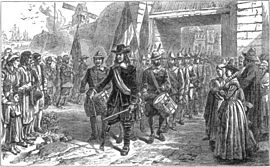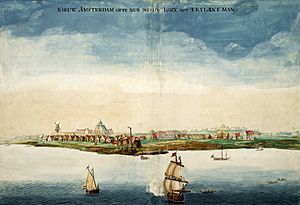Conquest of New Netherland facts for kids
Quick facts for kids Conquest of New Netherland |
|||||||
|---|---|---|---|---|---|---|---|
| Part of the Second Anglo-Dutch War | |||||||
 The surrender of Peter Stuyvesant in New Amsterdam (by Charles Hemstreet) |
|||||||
|
|||||||
| Belligerents | |||||||
| Commanders and leaders | |||||||
| Richard Nicolls Samuel Maverick |
Peter Stuyvesant Johannes de Decker |
||||||
| Strength | |||||||
|
almost none deployed | ||||||
| Casualties and losses | |||||||
| none | 3 killed, 10 wounded (in New Amstel) | ||||||
The conquest of New Netherland happened in 1664. An English group led by Richard Nicolls arrived in New York Harbor. They took control of New Amsterdam peacefully. The two sides agreed to the Articles of Surrender of New Netherland. Most of the colony was taken without a fight. However, there was some fighting in New Amstel.
Contents
Why the English Wanted New Netherland
The Dutch and English were rivals in trade. This led to the First Anglo-Dutch War. Even after the Treaty of Westminster (1654), their trading companies kept clashing. There were also religious and political differences. The English had Anglican royalists. The Dutch had Calvinist republicans. These differences made it hard to keep the peace.
Trade Rivalry and Royal Ambitions
During the Anglo-Spanish War (1654–1660), Dutch traders became very strong. They took over trade with Spain and its lands. This included places in Italy and America. In England, King Charles II of England wanted a popular war. He hoped it would make him a stronger king. Many naval officers also wanted to fight the Dutch.
How New Amsterdam Was Captured
In March 1664, King Charles II gave a large area of American land to his brother, James. This land was between the Delaware and Connecticut rivers. On May 25, 1664, Colonel Richard Nicolls left Portsmouth. He had four warships and about 300 soldiers.
English Forces Arrive
They reached Gravesend Bay on Long Island on August 27. English towns nearby helped them. Their local militias joined Nicolls' forces. They then moved west towards Breuckelen. Nicolls sent a letter to the Dutch leader, Peter Stuyvesant. The letter offered easy terms for surrender. James wanted the colony to stay in good shape. He preferred its profits over fighting and ruining it.
Stuyvesant's Decision to Surrender
Fort Amsterdam did not have much gunpowder. Still, Stuyvesant wanted to fight. On September 4, the English ships moved closer to the fort. Stuyvesant was then faced with a difficult choice. Ninety-three important citizens and even his own son urged him to give up. He finally agreed.
Signing the Surrender Agreement
A group of important Dutch merchants met with Nicolls' officers. They met at Stuyvesant Farm. They worked together to write the Articles of Capitulation. These articles promised many things to the Dutch colonists. They could keep their property. Their laws about inheritance would stay the same. They would also have religious freedom.
The agreement was signed on September 6, 1664. Johannes de Decker, Stuyvesant's lawyer, signed it on a ship. The next day was Sunday, so the transfer happened on September 8. Dutch soldiers marched down Beaver Street. They boarded the ship Gideon and sailed to Holland. Nicolls then became the new deputy-governor.
Surrender of Fort Orange
On September 10, Johannes de Decker sailed north. He went to Fort Orange. He wanted to warn them about the British. He also hoped to gather people to resist. But Nicolls sent troops to demand the fort's peaceful surrender.
Fort Orange Becomes Fort Albany
The Dutch leaders at Fort Orange knew the English controlled the river's mouth. This meant the English controlled their future. So, on September 24, 1664, Johannes de Montagne surrendered the fort. Colonel George Cartwright took command. The next day, Captain John Manning took charge. The fort was renamed Fort Albany. This was after the Duke of York's title. While there, Cartwright also renewed the Dutch treaty with the Iroquois people.
Esopus Surrenders Peacefully
On his way back down the river, Cartwright stopped at Esopus. This settlement also surrendered without a fight. Cartwright was careful to be fair to the residents. He let the local Dutch officials stay in power. A group of soldiers was placed in charge of the fort. Captain Daniel Brodhead commanded them.
Capture of New Amstel
At the same time, Nicolls sent Sir Robert Carr south. Carr was to take control of the land the Dutch had taken from Sweden. The English took Fort Altena peacefully. Alexander D’Hinoyossa, the leader of New Amstel, went to Fort Casimir with some followers.
Fighting at Fort Casimir
Carr fired cannons at Fort Casimir. Then his soldiers attacked and took the fort. His soldiers also took goods from the nearby settlements. This happened even though the people there did not fight back. They took property, crops, and many animals. They also damaged a brewery and a sawmill.
Carr's Actions and Nicolls' Displeasure
Carr then went further south. He took goods from a Mennonite settlement. This settlement was near what is now Lewes, Delaware. Carr's actions made Nicolls very angry. Nicolls wanted to avoid conflict between the settlers and the new government. He was also upset that Carr seemed to be profiting from his actions. Nicolls visited New Amstel. He renamed it New Castle. He also appointed a new commander. However, he could not make Carr give back what he had taken. Nicolls returned to New York without him.


